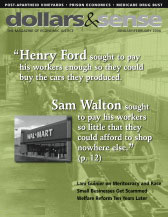
Dear Dr. Dollar:
Can you explain how poverty is defined in government statistics? Is this a realistic definition?
—Susan Balok, Savannah, Ga.
This article is from the January/February 2006 issue of Dollars and Sense: The Magazine of Economic Justice available at http://www.dollarsandsense.org

This article is from the January/February 2006 issue of Dollars & Sense magazine.
Subscribe Now
at a 30% discount.
Each February, the Census Bureau publishes the federal poverty thresholds—the income levels for different sized households below which a household is defined as living “in poverty.” Each August, the bureau reports how many families, children, adults, and senior citizens fell below the poverty threshold in the prior year. As of 2004, the federal poverty thresholds were as follows:
| Household Size | Federal Poverty Threshold |
|---|---|
| 1 person | $ 9,310 |
| 2 people | 12,490 |
| 3 people | 15,670 |
| 4 people | 18,850 |
| 5 or more | Add $3,180 per person |
Using these income levels, the Census Bureau reported that 12.7% percent of U.S. residents and 17.8% of U.S. children lived in poverty in 2004. Black Americans experience poverty at nearly double these rates: 24.9% of all Blacks and 33.3% of Black children live in households with incomes below the poverty line.
The poverty threshold concept was originally devised by Social Security analyst Mollie Orshansky in 1963. Orshansky estimated the cost of an “economy food plan” designed by the Department of Agriculture for “emergency use when funds are low.” Working from 1955 data showing that families of three or more spent one-third of their income on food, Orshansky multiplied the food budget by three to calculate the poverty line. Since the early 1960s, the Census Bureau has simply recalculated Orshansky’s original figures to account for inflation.
The poverty line is widely regarded as far too low for a household to survive on in most parts of the United States. For one thing, as antipoverty advocates point out, since 1955 the proportion of family budgets devoted to food has fallen from one-third to one-fifth. Families expend far more on nonfood necessities such as child care, health care, transportation, and utilities today than they did 50 years ago, for obvious reasons: mothers entering the work force, suburbanization and greater dependence on the auto, and soaring health care costs, for example. Were Orshansky formulating a poverty threshold more recently, then, she would likely have multiplied a basic food budget by five rather than by three.
Furthermore, costs--particularly for housing and energy--vary widely across the country, so that an income that might be barely adequate in Mississippi is wholly inadequate in Massachusetts. Yet federal poverty figures make no adjustment for regional differences in costs.
A number of state-level organizations now publish their own estimates of what it takes to support a family in their area, in conjunction with the national training and advocacy group Wider Opportunities for Women. Using local data on housing costs, health care premiums, taxes, and child care costs as well as food, transportation and other necessities, these “self-sufficiency standards” estimate that a two-parent two-child family needs between $40,000 and $50,000 a year, depending on the region, to cover basic needs.
State and federal officials often implicitly recognize that official poverty thresholds are unrealistically low by setting income eligibility criteria for antipoverty programs higher than the poverty level. Households with incomes of 125%, 150%, or even 185% of the federal poverty line are eligible for a number of federal and state programs. In addition, the Census Bureau publishes figures on the number of households with incomes below 200% of the federal poverty line--a level many social scientists call “near poor” or “working poor.”
Poverty calculations also have critics on the right. Conservative critics contend that the official poverty rate overstates poverty in the United States. While the Census Bureau’s poverty-rate calculations include Social Security benefits, public assistance, unemployment and workers’ compensation, SSI (disability) payments, and other forms of cash income, they exclude noncash benefits from state and federal antipoverty programs like Food Stamps, Medicaid, and housing subsidies. If the market value of these benefits were counted in family income, fewer families would count as “poor.” On the other hand, by not counting such benefits, policy makers have a better grasp of the numbers of Americans in need of such transfer programs.
Resources: For background information on poverty thresholds and poverty rate calculations, see aspe.hhs.gov/poverty/papers/hptgssiv.htm. Self-sufficiency standards for different states can be found at www.sixstrategies.org/states/states.cfm. In addition, the Economic Policy Institute has calculated family budgets for the 435 metropolitan areas: www.epi.org/content.cfm/datazone_fambud_budget.
Did you find this article useful? Please consider supporting our work by donating or subscribing.
